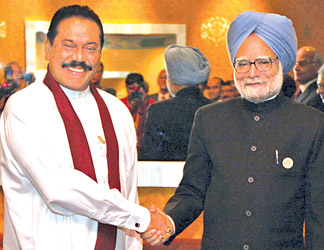Sri Lanka: the State of Nation and relations with India
Text of the
presentation made by High Commissioner for Sri Lanka in India Prasad
Kariyawasam at the National Defence College (NDC) of India recently
The concept of Nation States is of recent origin. The genesis of the
modern State system and the ‘Doctrine of Sovereignty and Equality of
States’ are as recent as 1648 and the Peace of Westphalia.
Relations between India and Sri Lanka, however, are ancient and
predate the Peace of Westphalia and the modern State system. Bonds
between our peoples, our kings and our rulers are even older than
recorded history.
|

Strengthening ties: President Mahinda Rajapaksa meeting Indian
Prime Minister Dr Manmohan Singh |
Somehow, with the evolution of history, the long years of colonial
rule, the travails of freedom struggles and Independence, and the
efforts thereafter to govern in the modern Nation State System, which
itself is evolving; while dealing at the same time with several
complications inherited from colonial rule; resulted in the blurring of
the ties that bound our people in the ancient past.
Suicide bombings
Today, with the end of terrorism that plagued Sri Lanka for 30 years,
and the rise of India on the world stage, we have a historic opportunity
to once again go back to building our traditional friendships and
restore our age-old ties. And this is a path that our two nations have
already embarked upon.
What most of you would have been exposed to on Sri Lanka in recent
times are the headline grabbing events of the last 30 years - the
terrorism and the suicide bombings.
For that reason, I want to first set before you, very briefly, what
Sri Lanka was, historically and what relations between India and Sri
Lanka were in a historical context.
A strong influence on Sri Lanka’s history right throughout, for
thousands of years, has been her position in the Indian Ocean, namely,
her strategic location: an island, located midway between East and West.
For over 2000 years before the advent of the colonial powers, Sri Lanka
served as a safe and important entrepot, providing ports for the
exchange of goods between East and West; a contact point between two
great regions. What has been called the opulent commerce of ancient Sri
Lanka is well described by a Greek trader who visited around the fifth
Century:
‘Sieldiba (or Taprobane) being thus placed in the middle as it were
of India, receives goods from all nations, and again distributes them,
thus becoming a great emporium....As its position is central, the island
is the resort of ships from all parts of India, Persia and Ethiopia and
in like manner, many are despatched from it. From the inner countries, I
mean China, and other emporiums, it receives silk, aloes, cloves,
clove-wood, sandalwood, and whatever else they produce.
These it again transmits to the outer ports, I mean to Malabar, when
the pepper comes; to Calliana (near Bombay), where there is brass and
sesamine wood, and materials for dress, and to Sind, where they get
musk, castor, and androstachum, to Persia, the Homeritic coasts
(southern Arabia) and Adule.
Receiving in return the exports of those emporiums, Taprobane
exchanges them in the inner ports sending her own produce along with
them to each.’
Sri Lanka, since time immemorial, has seen the continual absorption
of influences from the outside world. This is evident in the
multilayered make up of the population, its manners, its traditions,
culture, architecture, food and attire. But, throughout history, the
people of Sri Lanka have displayed a resistance to attempts at physical
conquest.
Historical chronicles
Being divided by India by just 30 miles, a narrow strip of Sea, Sri
Lanka has been close enough to India to be influenced throughout
history, but remained fiercely independent so as to preserve a distinct
individuality.
The history of Sri Lanka from the third Century BC onwards is one of
the best documented in the region. The island has a collection of
historical chronicles and religious writings which have no parallel in
South Asia. Recorded history begins over 2300 years ago when Emperor
Asoka of India sent his son and daughter to Sri Lanka. They set out to
Sri Lanka from Sanchi and were received in Sri Lanka’s ancient Kingdom
of Anuradhapura. This is an important civilizational link between our
two countries.
A sapling of the Pipal tree under which Prince Siddharta attained
enlightenment as Gautama Buddha in Bodhgaya, was taken to Sri Lanka by
Emperor Asoka’s daughter. That tree continues to stand in Anuradhapura
even today.
Culture and civilisation
It is acknowledged as the oldest recorded tree in the world and has
remained in continuous worship since the inception in third Century BC.
For nearly 13 centuries, Anuradhapura remained the principal seat of
government and the major centre of Sri Lankan culture and civilisation.
Its monasteries were great centres of learning, visited by scholars and
pilgrims from many parts of Asia. It housed an international trading
community, which included traders from India, China, Rome, Arabia and
Persia. It was from the court at Anuradhapura that Sri Lankan
ambassadors were despatched on several occasions to the imperial courts
of Rome and China. The Great Indian Buddhist scholar and commentator,
Buddhaghosa, spent many years in Anuradhapura during the fifth Century,
codifying the Buddhist scriptures which had been lost in India.
Gunavarman, the Kashmiri monk, who carried Buddhism to Indonesia and
China, passed through Sri Lanka, and must certainly have visited the
city’s monasteries. Monks from Anuradhapura went out to many lands, such
as India, China, Cambodia and Java, leaving there, inscriptions and
records of their visits.
To be continued |



